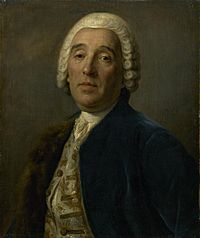Francesco Bartolomeo Rastrelli facts for kids
Francesco Bartolomeo Rastrelli (born in Paris, Kingdom of France, in 1700 – died in Saint Petersburg, Russian Empire, on April 29, 1771) was a famous Italian architect. He spent most of his life working in Russia. He created a special style of architecture called Late Baroque. This style was known for being very grand and fancy. His most famous buildings, like the Winter Palace in Saint Petersburg and the Catherine Palace in Tsarskoye Selo, are known for their amazing luxury and rich decorations.
Contents
Who Was Francesco Rastrelli?
Early Life and Career
In 1716, when Francesco was 16, he moved to Saint Petersburg. This city had just become the new capital of Russia a few years before. He came with his father, Carlo Bartolomeo Rastrelli, who was a sculptor. Francesco wanted to mix the newest Italian building styles with the older Russian traditions.
His first big job came in 1721. He was asked to build a palace for Prince Demetre Cantemir, who used to rule Moldavia.
In 1730, he became the main architect for the royal court. The empresses of Russia really liked his work. He kept his job during the reigns of Empress Anna (1730–1740) and Empress Elizabeth (1741–1762).
Working for Empresses
Empress Elizabeth, the daughter of Peter the Great, was careful about who she trusted. After looking at all the architects in Saint Petersburg, she decided that Francesco Rastrelli was the best. So, he started working for her in 1744.
Rastrelli's last big project was the Smolny Convent in St. Petersburg. Empress Elizabeth planned to live there for the rest of her life. The bell-tower he designed was meant to be the tallest building in St. Petersburg and all of Russia. But Elizabeth died in 1762, and Rastrelli could not finish this huge plan.
The new empress, Catherine II, did not like the Baroque style. She thought it was old-fashioned. So, Rastrelli retired. He moved to Courland and helped finish some palaces there.
He was chosen to join the Imperial Academy of Arts a few months before he passed away. A square in front of the Smolny Convent is named after him. An Italian composer, Lorenzo Ferrero, even wrote music about him called Rastrelli in Saint Petersburg.
Rastrelli's Family
Francesco lived with his father and mother. He also had a wife named Maria and three children. Sadly, his son Joseph Jacob died in December 1737 from cholera. His daughter Eleanor died in January 1738.
Rastrelli's Famous Buildings
Between 1744 and 1760, Rastrelli built many of his most famous buildings for Empress Elizabeth:
- The Summer Palace (this wooden palace was later taken down).
- A wooden Winter Palace on the Nevsky (this was also taken down).
- The stone Winter Palace (this still stands and is now the main building of the Hermitage Museum).
- The Smolny Convent and Cathedral, with four churches.
- The Palace for Chancellor Vorontsov (now a military school).
- The Stroganov Palace (now part of the State Russian Museum).
- The palace in Tsarskoye Selo (this has been restored and is now a museum).
- He also finished and decorated the inside of the Anichkov Palace in St. Petersburg.
Buildings You Can Still See Today
Here are ten buildings designed by Rastrelli that you can still visit:
| # | Image | Name | Location | Date |
|---|---|---|---|---|
| 1 | 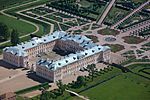 |
Rundāle Palace | Pilsrundāle near Bauska |
1736–1740 1764–1767 |
| 2 | 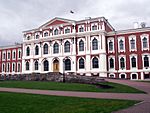 |
Jelgava Palace | Jelgava |
1738–1740 1763–1772 |
| 3 |  |
Peterhof Palace | Peterhof near St. Petersburg |
1747–1755 |
| — | 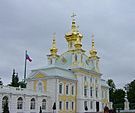 |
Peterhof Palace chapels | Peterhof near St. Petersburg |
1747–1751 |
| 4 | 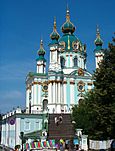 |
Saint Andrew's Church | Kyiv |
1748–1767 |
| 5 |  |
Smolny Convent | St. Petersburg |
1748–1764 |
| 6 |  |
Vorontsov Palace | St. Petersburg |
1749–1757 |
| 7 | 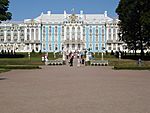 |
Catherine Palace | Tsarskoe Selo (Pushkin) |
1752–1756 |
| — | 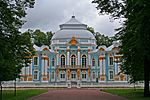 |
Hermitage Pavilion | Tsarskoe Selo (Pushkin) |
1749 |
| 8 | 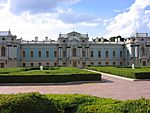 |
Mariyinsky Palace | Kyiv |
1752 1870 |
| 9 |  |
Stroganov Palace | St. Petersburg |
1753–1754 |
| 10 |  |
Winter Palace | St. Petersburg |
1754–1762 |
Buildings That Are No Longer There
Some of Rastrelli's buildings were later taken down or changed:
| # | Image | Name | Notes | Location | Date |
|---|---|---|---|---|---|
| 1 |  |
Annenhof | Made of wood, later replaced by another palace. | Lefortovo District, Moscow |
1731 moved 1736 burnt down 1746 |
| 2 |  |
Anna's Winter Palace | Replaced by the current Winter Palace. | Saint Petersburg |
1732–1735 taken down 1754 |
| 3 |  |
Summer Palace | Made of wood, later replaced by another castle. | Saint Petersburg |
1741–1744 taken down 1797 |
| 4 |  |
Winter Kremlin Palace | Replaced by the Grand Kremlin Palace. | Moscow Kremlin |
1747–1756 rebuilt 1798 taken down 1837 |
How Rastrelli is Remembered
Rastrelli is a very important figure in Russian Baroque style. Pictures of his buildings, especially those in Tsarskoe Selo, were shared across Europe during his lifetime. You can still find some of these pictures in collections in Ukraine and Germany.
- A statue of Rastrelli was placed in Tsarskoye Selo.
- Another statue of him is in St. Manege Square in St. Petersburg.
- In 1972, a documentary film called "Architect Rastrelli" was made about him.
- One of the squares in St. Petersburg is named Rastrelli Square.
- A group of Russian cellists is called the Rastrelli Quartet. They play music from different time periods, from Baroque to modern.
See also
 In Spanish: Francesco Bartolomeo Rastrelli para niños
In Spanish: Francesco Bartolomeo Rastrelli para niños


